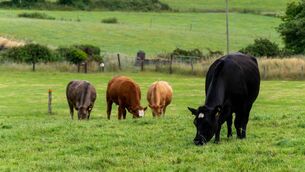Brian Reidy: The causes and cures for heating in grass silage

Most yards have silage pits open by now, and this is a significant issue that needs to be addressed. File photo
More than in other years, I’m encountering quite a few grass silage pits that are heating and going off very quickly once opened — whether being fed in blocks or through a total mixed ration (TMR).
Most yards have silage pits open by now, and this is a significant issue that needs to be addressed.
Dealing with heating in grass silage is a serious concern, as it affects feed quality and can lead to spoilage and underperforming livestock.
Here are some practical steps to help manage the issue — both immediately and for future harvests.
If silage isn’t fermented properly, spoilage can occur.
Common causes include:
- Grass too dry or too wet
- Ensiled too quickly or too slowly
- Low sugar content
Yeasts drive secondary fermentation, generating heat. Moulds can thrive in silage that’s not well managed, worsening the problem.
Contaminants:
- Dirt, clay, slurry or poor field hygiene can introduce unwanted bacteria.
- Poor practice around fertiliser timing, mowing, tedding, raking, and pick-up increases risk.
Aim for 70–75% moisture (25–30% dry matter). If moisture is too high, consider adding a dry absorbent (such as pulp or hulls).
Grass silage for pit storage should never sit on the ground longer than 24 hours. Harmful microbes multiply sixfold per hour beyond that point.
If grass is dry pre-harvest, ensile it quickly to avoid over-drying. Over-wilting and excessive tedding often do more harm than good.
- Pack tightly to remove air pockets. Avoid pushing in a full trailer load at once — thick layers can’t be consolidated.
- Use a heavy tractor or roller to compact the pit effectively.
- Apply plenty of weight over the plastic.
- Use side sheeting and an oxygen barrier film to seal completely — most waste occurs at the top and sides.
- Ensure all edges are well covered to prevent air ingress.
- This year, many pits are showing spoilage and heating throughout — not just at the surface — so attention to detail is essential.
Improper sealing: If the pit isn’t sealed correctly, air will enter and encourage aerobic bacteria that generate heat.
Check regularly for holes in the plastic cover, as even small punctures or tears can cause major issues.
Check silage temperature routinely. If it exceeds 20°C, take corrective action.
Warm weather can worsen heating, especially in poorly packed or sealed silage.
Consider silage additives to promote fermentation and suppress spoilage organisms.
When applied accurately, they are proven to work very effectively.
- Use heated silage quickly to minimise losses.
- Mix with other feeds to improve palatability and digestibility.
- Get across the pit faster by taking out shallower layers each time.
- Use a shear grab to reduce the exposed surface area.
- Avoid leaving plastic draped over the pit face — it traps heat.
- Feed freshly each day; heating silage left for multiple days leads to massive waste, poor intake, and poor animal performance.
- If using a mixer wagon, avoid over-mixing — especially with wetter, heating silage — as this can form rejected feed “balls.”
Once heating starts, there’s no successful chemical fix. Good physical management is the only solution.
If the problem persists or worsens, consult a nutritionist or silage specialist for tailored advice.
In most cases where heating is observed, a mycotoxin binder will also be necessary to prevent production losses, illness, feed rejection, or animal health issues.
Understanding the causes — and acting quickly — will help you protect your silage quality and keep stock performing to their potential.














